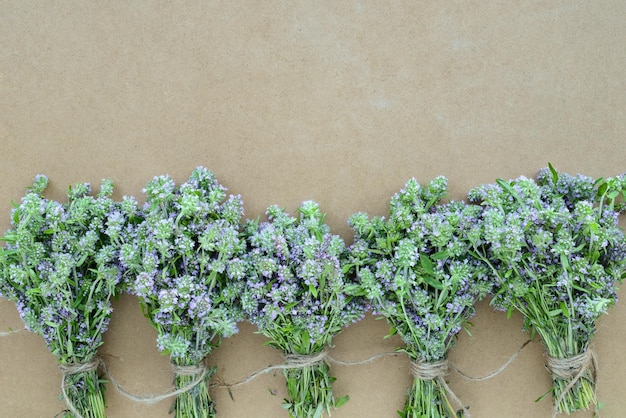Rosemary & Thyme: Growing, Harvesting, And Using These Aromatic Herbs

Table of Contents
Growing Rosemary and Thyme
Successfully growing rosemary and thyme begins with understanding their basic needs. Both herbs thrive in similar conditions, making them ideal companions in your herb garden.
Choosing the Right Location and Soil
Rosemary and thyme are sun-worshippers! They need at least six to eight hours of direct sunlight daily to flourish. Well-draining soil is crucial; these herbs are susceptible to root rot in soggy conditions. Aim for a slightly alkaline to neutral soil pH (6.0-7.5).
- Optimal sunlight hours: 6-8 hours of direct sunlight per day.
- Ideal soil drainage techniques: Amend heavy clay soil with compost or other organic matter to improve drainage. Consider raised beds or containers for better control over drainage.
- Soil pH testing and adjustment: Use a soil testing kit to determine your soil's pH. Adjust accordingly with lime to raise the pH or sulfur to lower it.
Planting Rosemary and Thyme
You can propagate rosemary and thyme from seeds, cuttings, or established plants. Starting from seed can be challenging, especially with rosemary, which often benefits from a little extra warmth and care. Cuttings are generally more successful.
- Starting rosemary from seed vs. cuttings: Sow seeds indoors 6-8 weeks before the last frost. Cuttings are easier and more reliable; take 4-6 inch cuttings in spring or early summer.
- Transplanting thyme seedlings: Thyme seedlings can be transplanted outdoors after the last frost, spacing them 6-12 inches apart.
- Spacing recommendations: Space rosemary plants 2-3 feet apart, allowing room for their mature size.
Care and Maintenance
Once established, rosemary and thyme are relatively low-maintenance. Overwatering is a greater threat than underwatering. Fertilize sparingly; these herbs prefer poor to moderately fertile soil. Regularly check for pests and diseases.
- Watering frequency based on climate: Water deeply but infrequently, allowing the soil to dry out slightly between waterings. Adjust watering frequency based on your climate and weather conditions.
- Organic fertilizer options: Use a balanced, organic fertilizer sparingly in spring. Compost tea or worm castings are excellent choices.
- Pest and disease prevention strategies: Inspect plants regularly for pests like aphids or spider mites. Use organic pest control methods if necessary.
Harvesting Rosemary and Thyme
Harvesting your rosemary and thyme at the right time and using the proper techniques ensures maximum flavor and aroma.
Knowing When to Harvest
The best time to harvest thyme is before it flowers, typically in late spring or early summer. Rosemary can be harvested as needed throughout the growing season, pruning to encourage bushier growth.
- Identifying mature thyme plants: Thyme is ready for harvesting when it has developed several inches of growth.
- Recognizing ideal rosemary harvest times: Harvest rosemary sprigs as needed, taking no more than one-third of the plant at any time.
- Signs of overgrowth: Overgrown, woody stems indicate it's time for a more significant pruning.
Harvesting Techniques
You can harvest rosemary and thyme by pruning or cutting sprigs. Pruning encourages bushier growth, while cutting sprigs provides herbs for immediate use.
- Pruning techniques for bushy growth: Pinch back growing tips to encourage bushier growth and prevent legginess.
- Harvesting sprigs for immediate use: Snip sprigs from the plant using sharp scissors or shears.
- Drying methods for long-term storage: Air drying is best for preserving flavor and aroma. Bundle sprigs and hang them upside down in a cool, dark, well-ventilated area.
Preserving Rosemary and Thyme
Proper preservation ensures you can enjoy the flavors of rosemary and thyme year-round.
- Air drying vs. oven drying: Air drying retains more flavor and aroma. Oven drying is faster but requires careful monitoring to prevent burning.
- Freezing techniques for herbs: Chop herbs finely and store them in freezer bags or ice cube trays with water or oil.
- Infusing oils with rosemary and thyme: Infuse olive oil or other oils with rosemary and thyme for a flavorful addition to cooking.
Using Rosemary and Thyme in Cooking and Beyond
Rosemary and thyme are incredibly versatile herbs, enhancing a wide variety of dishes. Their uses extend beyond the culinary world.
Culinary Applications
These herbs add depth and complexity to many dishes.
- Rosemary-infused lamb: Rosemary pairs beautifully with lamb, creating a classic flavor combination.
- Thyme in chicken dishes: Thyme's subtle, earthy flavor complements chicken perfectly.
- Rosemary bread: Rosemary adds a distinctive aromatic note to breads and rolls.
- Thyme in vegetable soups: Thyme enhances the flavor of vegetable soups and stews.
Other Uses
Beyond the kitchen, rosemary and thyme find applications in aromatherapy, natural remedies, and more.
- Rosemary essential oil uses: Rosemary essential oil is used in aromatherapy for its stimulating properties.
- Thyme in natural cleaning products: Thyme's antiseptic properties make it useful in homemade cleaning solutions.
- Rosemary for hair care: Rosemary is believed to promote hair growth and reduce hair loss.
Conclusion
Growing, harvesting, and using rosemary and thyme offers a rewarding experience for home cooks and gardeners alike. From selecting the right location and soil to mastering harvesting and preservation techniques, this guide provides all the essential information you need to enjoy these versatile herbs. Start your journey into the fragrant world of rosemary and thyme today! With a little care, you can enjoy the abundance of these versatile herbs in your cooking and beyond. Learn more about growing your own rosemary and thyme and experience the difference fresh herbs make!

Featured Posts
-
 Spring Hotel Deals Up To 30 Off Lavish Stays
May 31, 2025
Spring Hotel Deals Up To 30 Off Lavish Stays
May 31, 2025 -
 Indian Wells Masters Alcaraz Chung Ket Dang
May 31, 2025
Indian Wells Masters Alcaraz Chung Ket Dang
May 31, 2025 -
 Griekspoor Upsets Top Seed Zverev At Indian Wells
May 31, 2025
Griekspoor Upsets Top Seed Zverev At Indian Wells
May 31, 2025 -
 Uncertain Trump The Hesitation Before Musk Left
May 31, 2025
Uncertain Trump The Hesitation Before Musk Left
May 31, 2025 -
 Soaring Pet Bills In The Uk The Impact Of Corporate Veterinary Targets
May 31, 2025
Soaring Pet Bills In The Uk The Impact Of Corporate Veterinary Targets
May 31, 2025
